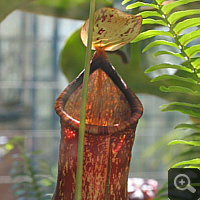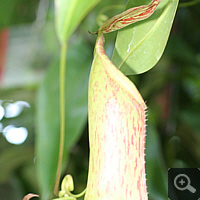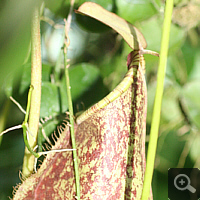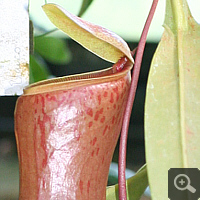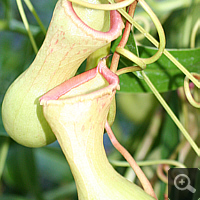Pitcher Plant (Nepenthes)
Overview
The genus Nepenthes includes circa 90 species, of these are the most to be found in Southeast Asia. Two species grow on Madagascar, one species in North Australia, in addition exist isolated habitats in India and Sri Lanka. Evolutionary biological Pitcher Plants are with circa 20 – 30 million years old fossil finds about a relative old genus. Amongst the carnivorous plant it is the only one dioecious genus.
In principle, Pitcher Plants can be differentiated into two main groups. First of all this has vital importance for their culture. On the one hand exist lowland Nepenthes which are to be found under 1.000 m above sea level and which wish a completely warm and humid place. On the other hand exist highland Nepenthes which grow above 1.000 m SL. These species require a nocturnal fall of temperature.
The vast majority of Pitcher Plants grows terrestrial, only a few species grow epiphytic. At first a rosette with lower pitchers is produced. In old age, the plants produce a liana-like tendril. At the same time internode distance becomes longer. Many species produce now upper pitchers, which differ partly distinctly from lower pitchers. Botanical speaking, the capped pitchers are transformed leaves, the putative leaves of Pitcher Plants belong to the true leafstalk. At first, pichters grow up as a closed bladder. When the lid opens up, the pitcher is mostly full-grown and already filled with enzyme-rich liquid. After opening the lid is immobile. Pitcher size is depending on the species between 3 – 50 cm.
Trap mechanism
The principle trap mechanism was already detailed described on the previous site. The leafstalk with the broadening in the sense of a leaf transitions into a tendril, on which forward end the pitcher grows. This evolves initially as a closed bladder. Shortly before lid opens up, the pitcher is already filled with liquid and enzymes. After opening the lid is immobile, insects are attracted by a nectar production in the region of lid bottom and of peristome. This is smooth and often tops distinctly inwards as collar. The pitcher inside is covered by a smooth wax film. Insects fall from the smooth peristome and drown in pitcher liquid. An escape is prevented by the wax film and the overhanging peristome.
Culture and propagation
Pitcher Plants are no plants for beginners. As rainforest residents all species demand a high humidity (at least > 75%) and also a lot of light. Lowland Nepenthes demand all-the-year temperatures between 25 – 35 °C in the daytime. At night temperatures should not fall below 20 °C. By contrast, highland Nepenthes require lower temperatures with a distinct nocturnal fall. In the daytime temperatures should not be above 25 °C and at night not above 16 °C . Therefore, in the long run Pitcher Plants can actually be cultivated successfully only under glass. Because Pitcher Plants have a root system that is sensitive to waterlogging, soil indeed should be kept permanently moist, but never real wet. Watering in a permanent ebb and flood irrigation system is inappropriate thus. Soil has to be air- and water-permeable. Advisable is a loose mixture, which can be compounded for example from peat, quartz sand, Seramis, bark pieces, perlite, polystyrene chips and sphagnum moss.
Generative propagation is difficult. Seeds are only hard to get and germinable only for a short time. Better is a propagation by top cuttings. These take relatively fast roots under a high humidity and constant moist soil.
Reasons for a missing pitcher production
1. Too low humidity: Almost all species have a lowest limit of humidity of constant > 75%. Only some hybrids produce regularly pitchers in the case of lower values.
2. Too little light: Pitcher Plants demand a light location without direct sun. In the case of insufficient light conditions pitchers are not produced.
3. Missing thigmic stimulus: Some species only produce pitchers in the case that they have a contact stimulus. These species require a climbing frame. Only if the tendril can lean against something a pitcher will be produced.

